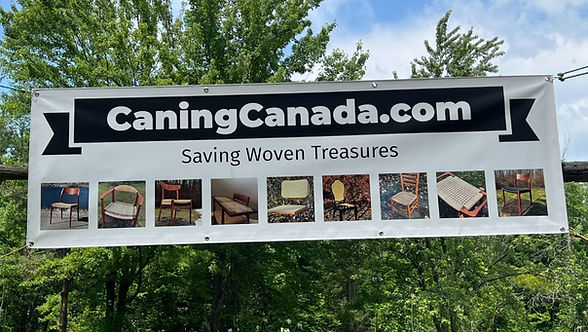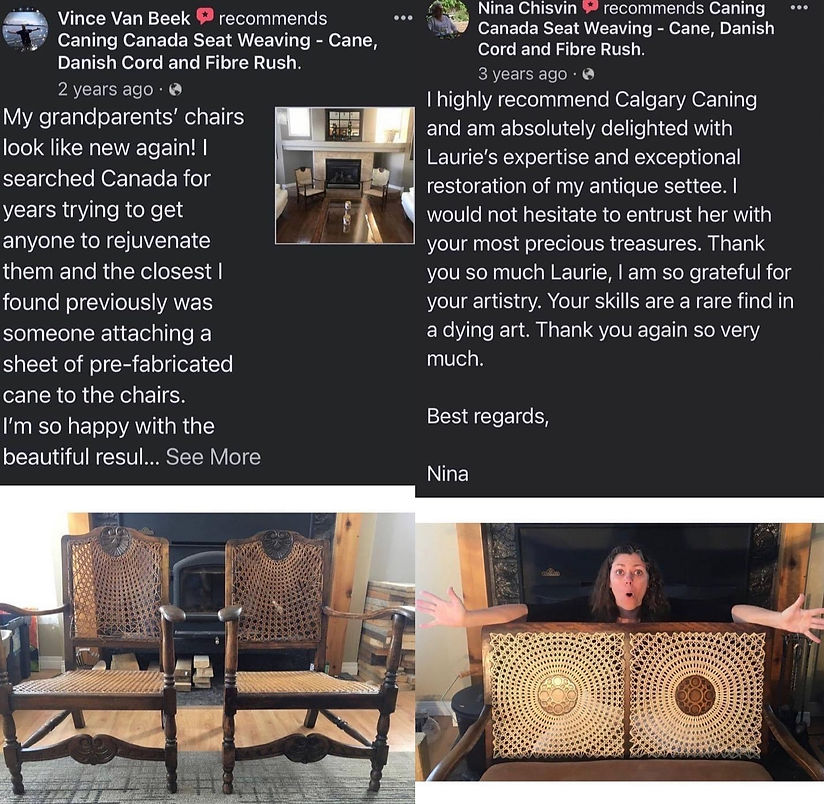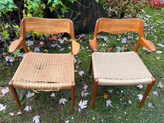Expert Woven Furniture Restoration Canada | Chair Weaving & Materials - Caning Canada
Save Your Heirloom Chairs
Hand-Woven Restoration Across Canada
Danish Cord · Seagrass · Hand & Pre-Woven Cane · Fibre Rush
Now Booking Beautiful British Columbia Winter Season

Text Photos for Free Quote → 403-613-5801
• 30+ Years Experience
• 1,000+ Happy Clients
• FSC-Certified Materials
• Nationwide Mobile + Mail-In
Internal Page Links
“Some things are too loved to throw away.”
Winter 2025–2026 Schedule (BC now)
Only a Handful of Winter Spots Left in BC
Contact Form
“Some things are too loved to throw away.”

“David and Laurie did an amazing job restoring our chairs. These chairs have been in my family longer than I have… All done in a week! Thanks again!”
– Cyril Tomlinson, Abbotsford, BC (November 19, 2025 – our newest 5-star review)
Text 403-613-5801 with photos — get your free quote in under 24 hours.
Choose Your Restoration
Winter 2025–2026 Schedule (BC Now)

We’re Wintering in Beautiful
British Columbia – Spots Filling Fast
• Victoria & Vancouver Island – November 27, 2025 (almost full)
• Vancouver – December 8, 2025
• Kelowna / Okanagan – March 2026
• Fort Langley (Seattle Drop-Off) – Flexible all winter
Spring–Fall 2026: Calgary • Edmonton • Toronto • Ottawa
Year-round mail-in everywhere else
Why Restore?

Restore Once. Love Forever.
• Save 30–60 % vs. buying new designer replicas
• Increase your chair’s value 20–50 %
• One dining chair restored = 75–120 kg CO₂e saved
• “Every strand you wove is a memory you saved.” – Jean T., Toronto
Ready to save money and the planet? Text photos to 403-613-5801
How It Works
(3 simple steps)
3 Easy Steps to a Stunning Chair
1. Text clear photos (top, bottom, close-ups) to 403-613-5801
2. Get your free quote + timeline in ≤24 hours
3. Drop off at a meet-up, mail it, or we pick up — pay only when it sparkles
Recent Reviews

Danish Cord Weaving:
Quick Scan
• Danish cord (definition: twisted paper cord for durable seats) for mid-century chairs.
• Ideal for Hans Wegner, Moller, Børge Mogensen, and Arne Hovmand-Olsen designs.
• Perfect for “Danish cord weaving Vancouver”.
• Stat: Lasts 20-50 years, cutting landfill waste.
Deeper Dive
Caning Canada uses FSC-certified Danish cord for single-rail (e.g., Moller 71) and envelope patterns (e.g., Wishbone Chair).
Sustainable weaves reduce fast furniture’s $114B environmental toll (Wiley).
“A chair should be beautiful from all sides,” said Wegner.
Book mobile in Calgary or mail-in from Ottawa via contact.
'I had my Moller 57 chairs restored by David and Laurie, and I’m so pleased with the results. Friendly and knowledgeable service with quick turnaround. Looking forward to enjoying these chairs for many more years to come.' - Nadya, Vancouver
What to ask next?
1. Explore Wegner designs? Read Wegner Chairs Blog.
2. Compare seagrass? See Seagrass.
3. Get a quote? Visit contact.
• Single Rail Danish Cord: Found in Moller 71, Poul Volther, and Skovmand chairs.

Moller 71 Chair Woven with Natural Danish Cord, Penticton, B.C.
• Double Rail Danish Cord: Iconic in Wegner’s Dining Chair 23.

Wegner Dining Chair 23 Woven with Natural Laced Danish Cord, Calgary, AB
• Rushing or Envelope Patterns: Seen in Wegner’s Wishbone Chair 24 and Armchair 22.

Wegner's Wishbone Chair 24 Woven with Natural Danish Cord, Calgary, AB
Our meticulous approach ensures your Danish cord furniture regains its original strength and elegance, whether in Calgary, Ottawa, or beyond.

Restored Danish Cord Moller Chairs, Toronto, ON
Binding Cane & Rattan Weaving

Hans J. Wegner Teak and Cane Round Chair, Vancouver, B.C.
Quick Scan
• Binding cane (definition: thick cane strips wrapped for support) for airy elegance.
• Suits Hans Olsen rockers, Wegner chairs.
• Ideal for “rattan weaving services Vancouver”.
• Stat: Diverts 1500 tonnes from landfills (Furniture Banks Canada).
Deeper Dive
Our no-nail wraps enhance lamps, shelves, and chairs without drilling.
'Laurie and David restored the seats on 2 of these French Canadian beauties for me. Absolutely perfectly woven in a beautiful style in Danish Cord, fairly priced, with a quick turnaround too. I highly recommend their services as they travel and work across Canada, sharing their knowledge of this near-lost art and making their services readily and efficiently available to customers. Follow them on Instagram and/or Facebook, or view their website and get on their wait-list and restore that quality chair with the damaged seat you've been hanging onto. You will be thrilled you did! It was such a pleasure to meet you both. Many, many thanks!' Tara, Vancouver
Book in Vancouver or mail-in via contact.
What to ask next?
1. See cane types? Check Pre-Woven Cane.
2. Learn more? Read Cane Furniture Blog.
3. Quote? Visit contact.

Client review for binding cane magazine shelf, Calgary, AB
Pre-Woven Cane Replacement
Quick Scan
• Pre-woven cane (definition: machine-woven webbing in grooves) for mid-century chairs.
• Fits Cesca chairs, daybeds.
• Ideal for “pre-woven cane repair Calgary”.
• Stat: Reduces wear by 40% (industry estimate).
Deeper Dive
We install press cane webbing with spline for a taut finish, perfect for Cesca chairs.
Sustainable vs. fast furniture’s 12M-ton landfill impact (EPA).
Book mobile in Calgary or mail-in from Toronto via contact.
What to ask next?
1. Cesca repairs? Read Cesca Chair Blog.
2. See handwoven? Check Handwoven Cane.
3. Quote? Visit contact.

Thonet Cantilever Armchair Model B64 by Marcel Breuer - Standard Weave

Set of vintage chairs with radio weave cane pattern in backrests

Arne Vodder For France & Daverkosen Cane Back Dining Chair - Close Weave
Handwoven Cane Weaving
Quick Scan
• Handwoven cane (definition: manual interlacing through drilled holes) for antiques.
• Ensures durability, intricate patterns.
• Ideal for “handwoven cane Canada”.
• Benefit: Eco-friendly, reduces waste.
Deeper Dive
Our artisans weave cane by hand, reviving antiques like bistro chairs and bentwood rockers. Sustainable repairs extend furniture life, combating fast furniture waste.
Book via contact for mail-in or mobile in Ottawa.
'I would like to thank Laurie for fixing an antique chair I inherited from my mom. It had been broken for years, and she was able to bring it back to its original glory. She completed it when she said she would and was very professional. Thanks again.' -Jude, Calgary
What to ask next?
1. Antique tips? Read Antique Cane Blog.
2. Compare seagrass? See Seagrass.
3. Book now? Visit contact.

Handwoven Caned Chair with Drilled Holes Through Frame

Client Reviews for Antique Handwoven Caned Pieces in Sunshine Pattern,
Calgary, AB
Seagrass Weaving:
Quick Scan
• Seagrass (definition: twisted grass ropes) for rustic chairs.
• Ages to brown patina.
• Ideal for “seagrass chair restoration Canada”.
• Benefit: Eco-friendly, durable.
Deeper Dive
Sourced from Asian meadows, seagrass adds rustic charm to ladderbacks. Our weaves ensure longevity, reducing environmental impact.
Book mobile in Vancouver or mail-in via contact.
What to ask next?
1. More on seagrass? Visit Seagrass page.
2. Explore benefits? Read Okanagan Weaving Blog.
3. Quote? Visit contact.

Borge Mogensen Chair Vancouver, B.C.

Gio Ponti Style Seagrass Chair, Vancouver, B.C.

Client Review for Borge Mogensen Seagrass Chair, Ottawa, ON
Fibre Rush Weaving Services
Quick Scan
• Fibre rush (definition: twisted paper mimicking natural rush) for sturdy seats.
• Affordable for vintage chairs.
• Ideal for “fibre rush repair near me”.
• Stat: Reduces waste (MDPI study).
Deeper Dive
Our triangular wraps suit rockers, converting rawhide designs.
Sustainable and cost-effective.
Book via contact for mobile in Calgary or mail-in.
What to ask next?
1. Full details? See Fibre Rush page.
2. Benefits? Read Vintage Restoration Blog.
3. Quote? Visit contact.

Fibre Rush Woven Laddarback Chair, Nanaimo, B.C.
Shaker Tape Weaving
Quick Scan
• Shaker tape (definition: flat cotton webbing) for minimalist chairs.
• Durable for rockers, ladderbacks.
• Ideal for “Shaker tape weaving Canada”.
• Benefit: Simple, sustainable.
Deeper Dive
Inspired by Shaker simplicity, our tape weaves restore porch rockers with clean lines.
Eco-friendly repairs extend furniture life. Book via contact.
What to ask next?
1. Designer focus? Read Moller Chairs Blog.
2. FAQs? See Frequently Asked Questions.
3. Book? Visit contact.

Shaker Tape Porch Rocker Montreal, QC
Woven Furniture Glossary
• Mid-century modern: 1940s-60s functional design with clean lines.
• Danish cord: Twisted paper cord for durable seats.
• Seagrass: Twisted grass ropes for rustic textures.
• Binding cane: Thick cane strips for structural support.
• Pre-woven cane: Machine-woven webbing in grooves.
• Handwoven cane: Manual interlacing through drilled holes.
• Fibre rush: Twisted paper mimicking natural rush.
• Shaker tape: Flat cotton webbing for minimalist weaves.
Woven Furniture Restorations | Frequently Asked Questions
Furniture weaving FAQ Canada: Ask and book.
-
What does woven furniture restoration involve?
-
It includes assessing damage, removing old woven surfaces, and reweaving with materials like Danish cord or cane for like-new results. Caning Canada also offers to check joints to strengthen where possible, and a cleaning and oiling service for most furniture pieces. For “woven furniture restoration Canada,” book with us.
-
-
How much does woven furniture restoration cost?
-
Costs vary by size and material; contact us for a free estimate. Affordable and quality-focused. Searching “woven restoration cost Canada”? Book your consultation.
-
-
What if my furniture has structural issues?
-
We handle minor repairs, cleaning and oiling of most pieces alongside weaving. For “structural woven repair,” contact Caning Canada.
-
-
Why restore woven furniture instead of replacing it?
-
Restoration preserves value and history while being cost-effective and eco-friendly. Query “benefits woven restoration Canada”? Book now.
-
-
What types of furniture can Caning Canada restore?
-
Caning Canada restores chairs, stools, benches, table shelves, and other furniture with woven elements, including mid-century and antique pieces.
-
-
How do I know if my chair is suitable for restoration by Caning Canada?
-
Send photos of your chair to Caning Canada via email or the website’s contact form for a free assessment of restoration suitability.
-
-
Does Caning Canada use traditional methods for furniture restoration?
-
Yes, Caning Canada employs time-honoured weaving techniques, ensuring restorations are authentic to the furniture’s original craftsmanship.
-
-
Can Caning Canada repair both modern and antique woven furniture?
-
Yes, Caning Canada restores both modern and antique furniture, specializing in materials like cane, rattan, and Danish cord.
-
-
How can I get an estimate for restoring my woven furniture with Caning Canada?
-
Submit photos and details via CaningCanada.com’s contact form or email, and receive a free, no-obligation restoration estimate.
-
Only a Handful of Winter Spots Left in BC
Get your heirloom holiday-ready or gift a restoration this Christmas.
Text Photos Instantly → 403-613-5801
Share your restoration story!
#CaningCanada #ChairRestoration #MidCenturyModern #VancouverIsland #SustainableCanadianCraft
Follow us on Instagram @caningcanada · Facebook · Subscribe for blog updates






















